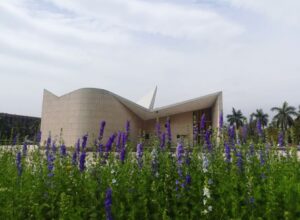This article is written by Vaibhav Goyal, a 4th year BA.LLB(H) student of University Institute of Legal Studies, Panjab University, Chandigarh.
“Lead us into the Light from Darkness”
Motto of Panjab University, Chandigarh
The University of Punjab at Lahore was set up on October 14, 1882. It was the fourth university of India although it was the main university that extended its scope from being an inspecting university to instructing and looking at both. Going before it was the University of Calcutta (set up on January 24, 1857), the University of Bombay (July 24, 1857), and the University of Madras (September 5, 1857).
The present-day Panjab University follows its foundations to the University of Punjab set up on 14 October 1882 at Lahore (presently in Punjab, Pakistan). The majority of the colleges are recognized at the University of Punjab were in the current Indian piece of British India.
After the partition of India in 1947, the university was parted into two for Indian Punjab and Pakistani Punjab. Another university was then settled/migrated to Punjab, India in 1947. To recognize the two, the name of the university on the Indian side, the spelling for ‘Punjab’ was changed to Panjab. After 1947 the university had no campus of its own for almost 10 years. The managerial office was in Solan and the instructing divisions worked from Hoshiarpur, Jalandhar, Delhi, and Amritsar.
In 1956 the university was moved to Chandigarh, on a red sandstone campus planned by Pierre Jeanneret under the direction of Le Corbusier. Until the re-organization of Punjab in 1966, the university had its provincial centers at Rohtak, Shimla, Jalandhar, and its recognized colleges were in the states of Punjab, Haryana, Himachal Pradesh, and U.T. of Chandigarh. With the re-organization of Punjab, the university turned into an Inter-State Body Corporate obliging the recently formed state of Punjab and Union Territory of Chandigarh.
The advancement of advanced education in India is fascinating. Till 1904, all universities had their resolutions. From that point, each of the five universities (the previously mentioned four and Allahabad University (set up November 16, 1889) were brought under the Indian Universities Act VIII of 1904. Numerous highlights proceed with all these five universities. These remember chose Senate and Syndicates for these establishments. Till 1947, the British set up in India 496 colleges and 21 universities, the last one being Sagar University in 1946.
Jugal Kishore Chowdhury was commissioned to create the original master plan for the campus; however, the reigns of the project were soon handed over to Jeanneret. The University’s in-house architect Bhanu Pratap Mathur carried out the detailing and implementation. It has several individual structures that are recognized landmark buildings of the Modernist Movement in India.
The University’s chequerboard format, concocted by Swiss-French Architect Pierre Jeanneret, was a good example of a campus plan in India. Pierre Jeanneret’s compositional heritage in Chandigarh is notable. Lesser known is that he worked resolutely on the end-all strategy and key structures of the Panjab University notwithstanding his part as the Chief Architect of Chandigarh. A significant part of the university’s legacy structures was deliberately directed by Pierre Jeanneret in the evening after he had completed his day at the Old Architect’s office as the City Chief.
Initiated in 1962, by Dr. S Radhakrishnan, it is the image of the University. The three-winged design of the Gandhi Bhawan is the most artistic structure of Panjab University. The structure’s preoccupied lotus structure addresses Gandhian beliefs, remaining in a pool of water amid finished gardens and lines of palms. It was celebrated with the dedicated Postal Stamp released by the Department of Posts, Government of India in 1989.
The campus of the university at Chandigarh is spread more than 550 acres of land in areas 14 and 25, the training territory is in the north-east, with the Central Library, Fine Arts Museum, and three-winged design of the Gandhi Bhawan framing its center; the sports complex, the health center, the dolphinarium, student center and the shopping center in the middle; 16 university inn and neighborhood in the south-east, extending into the contiguous area 25 which likewise houses the University Institute of Engineering and Technology and Dr. Harvansh Singh Judge Institute of Dental Sciences and Hospital, UIAMS, Institute of Biological Sciences and so forth
The campus has conveniences like a State bank of India branch, Post and Sampark, public vehicle framework, open-air theater, visitor and personnel houses, workshop buildings, staff club, several spacious lawns, botanical and medicinal herbs gardens, a recently laid rose nursery, a school and a day-care community for the representatives’ youngsters. The campus is adjoining a clinical organization known as the Post Graduate Institute of Medical Education and Research.
The scholastic establishments on the campus and four Regional Centers are assembled under the Faculties of Arts, Science, Languages, Law, Education and Fine Arts, Business Management and Commerce, Engineering and Technology, Medical Sciences, Pharmaceutical Sciences and Dairying, Animal Husbandry and Agriculture. The vast majority of the divisions have their particular libraries, and the working time frame runs for in any event 180 days in a year.
The University has its local area radio broadcast, Radio Jyotirgamaya 91.2, which goes about as a binding together specialist among the university staff, understudies, and the local area. The radio projects can be heard over a scope of 10 kilometers.
The QS World University rankings positioned it 291–300 in Asia in 2020 and 195 among BRICS countries in 2019. It was positioned 601–800 in the world by the Times World University Rankings of 2020, 149 in Asia, and 166 among Emerging Economies University Rankings in 2020.
In India, the Atal Ranking of Institutions on Innovation Achievements by the Ministry of Human Resource Development has positioned Panjab University 10 in general in 2019. The National Institutional Ranking Framework (NIRF) has positioned Panjab University 44th generally speaking in 2020, 26th among universities, 72nd in the designing positioning, 42 in the administration positioning, and second in India in the drug store positioning.
Panjab University has produced countless recognized alumni who have contributed massively to the development of the country. Some of them include Dr. Shankar Dayal Sharma (ninth President of India), Dr. Manmohan Singh (fourteenth Prime Minister of India), Inder Kumar Gujaral (twelfth Prime Minister of India), Dr. Hargobind Khorana (Nobel Laureate Biotechnologist responsible for producing the first man-made gene in his laboratory in the early seventies), Dr. Abdus Salam (Physicist, First Pakistani Nobel Laureate), Romila Thapar (Historian), Kalpana Chawla (Indian-American researcher and a NASA space explorer), Kiran Bedi (the first lady to join the IPS in 1972), and so forth.
References:
Chaman Lal, Panjab University: Journey and evolution, The Tribune, March 26, 2017
Official Website of Panjab University. Available at https://puchd.ac.in/
National Institutional Ranking Framework, Ministry of Human Resource Development, Government of India. Available at https://www.nirfindia.org/Home
Vice Chancellor’s Message, Gandhi Bhawan, Panjab University, Chandigarh. Available at http://gandhibhawan.puchd.ac.in/index.html

